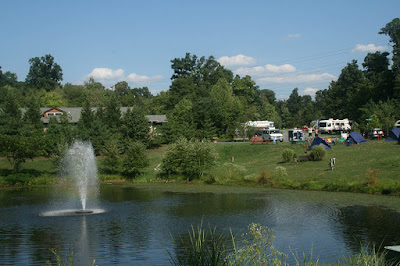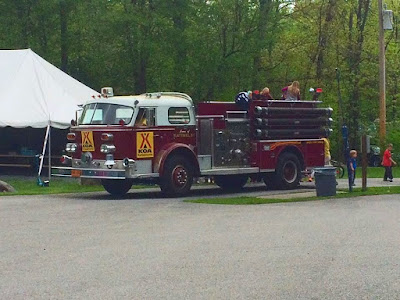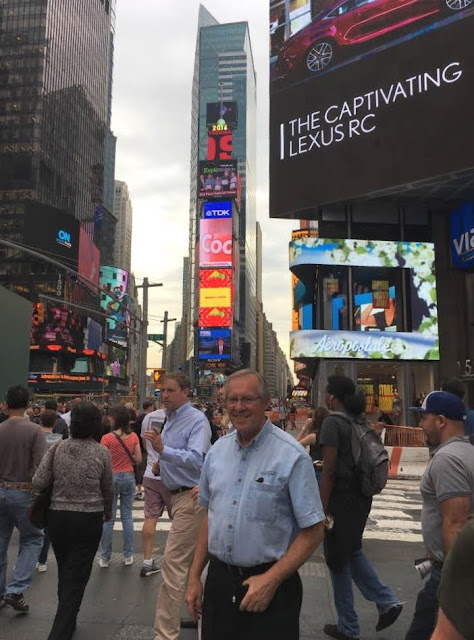Today, the entire central campus is a national landmark and home to many historic sites, buildings, and monuments including a military cemetery. Most of the campus’ Norman-style (military gothic) buildings are constructed from gray and black granite. The visitor center and museum are open to the public. A variety of escorted tours is available.
Tours are conducted by a vendor under contract with the Academy. Tour buses with driver and guide are used to travel around the grounds. We elected to take the longest tour known as the “cemetery tour.” On this tour were three stops; the Cadet Chapel (Protestant), cemetery, and parade grounds (for a walk to the northern view of the Hudson).
This aerial view of the Academy provides a comprehensive view. Most of the buildings, including the dormitory (barracks), are clustered along the southern portion of the campus on the hillside.
The athletic fields, parade grounds, cemetery, and faculty residences lie across
the flatter, northern portion. The Cadet Chapel can be seen rising on the left.
This view also provides an excellent perspective of the high and scenic hills
that line either side of the Hudson.
Our first stop was at the Cadet Chapel. It is the largest chapel on the campus and
serves the Protestant community. The flags hung on the sides represent the various
regiments as well as flags used during the history of the US.
There is also a Catholic and Jewish chapel as well as an Orthodox chapel and
an Interfaith Center. Each is located separately from the others.
No visit to this fine edifice would be complete without a look
at the massive organ console. The Cadet Chapel houses the
largest pipe organ in the world used for religious purposes.
Originally built by M.P. Möller of Hagerstown, MD. Today, the
instrument consists of 874 stops controlling 23,236 pipes
distributed across 12 divisions.
Our second stop on the tour was at the Old Cadet Chapel. It
now serves as the office for the cemetery though the
interior still appears as it did when first constructed.
One of the more unusual monuments (and the reason size restrictions
were enacted) is this mausoleum of Egyptian influence.
Probably the most photographed monument is
this one erected on the final location for the
remains of General Custer.
Immediately across from the large parade grounds is a park-like setting on the northern edge of the campus. From here one can see straight up the Hudson for several miles. From this point the river makes it’s relatively narrow curve around the rocky point southward.

Several links from the chain that was stretched across the Hudson
are displayed in the park that also displays cannons used
in wars throughout American history.
Looking across the parade grounds, an open view of the barracks is available with
the Cadet Chapel in the background.
The Coat of Arms of West Point U.S. Military Academy
prominently displays the motto of the institution: Duty, Honor, Country.
The year of 1802 is displayed in Roman numerals.
Our next jaunt was on the northern loop of the Shawangunk Scenic Byway. Though the drive is less than forty miles it can take a while to cover since there are several interesting stops along the way. The Shawangunk Mountains are a relatively short chain separating the Adirondacks from the Catskills. The northern loop surrounds the Mohonk Preserve and goes through the city of New Paltz, which is on the northeastern edge. Also within the northern loop of the Scenic Byway is the Minnewaska State Park and Wallkill Valley Rail Trail.
On the northern edge of Mohonk Preserve is the resort known as Mohonk Mountain House. It began operation in the late 19th century. Though we didn’t visit the Victorian-era resort with its castle-like appearance, we did drive past the old, now defunct, gateway that was used from the early 1900’s through the 1930’s.
Testimonial Gateway, as it is called, once served as the
official gateway on the drive to Mohonk Mountain House.
The private road was approximately ten miles in length
stretching across the valley to the Mountain House
which sits high atop the Shawangunk Ridge. The Gateway
is in the process of being restored although most of the
roadway was abandoned many years ago.
With the mountain on the northern edge and the valley and Mohonk Preserve along the south, Shawangunk Ridge may be viewed many miles away since it is so prominent in the landscape.
On the drive, we stopped at one of the farm businesses to get some fresh strawberries. Since the land isn’t appropriate for large fields of corn or soybeans so other forms of farming are prevalent. There are many vegetable and fruit farms. To say the least, this is “apple country” since dozens of orchards are scattered throughout this portion of New York State.
We also stopped in New Paltz to visit Historic Huguenot Street. A visit to this area will be covered in more detail near the end of this post since we returned there for a follow-up visit.
Finally, on June 16, we made our way into the City, “the Big Apple.” Along with nearly 30 other visitors from the KOA, we took the escorted tour by motorcoach. After weeks of telling registrants about the trip, we finally got to experience it for ourselves. (During the summer months the KOA hosts two or three trips per week into NYC using a bus and tour guide from West Point Tours).
As an aside, we need to fill in a few blanks. First, the many references to “kill” in the names of locations. The term comes from the Dutch language and references a body or water or creek. Second, “Big Apple.” During the Roaring 20’s when gambling, horse racing, and the rise of the stock market was prevalent, any major increase in winnings was referred to as “getting the big apple.” At the same time Jazz music was spreading in popularity from its base in New Orleans. When it hit New York many Jazz entertainers wanted to get to the City to “take a bite” out of the big apple; a piece of the action. Perhaps the most famous of these was Louis Armstrong who certainly took advantage of his turn at profiting from appearances in a few nightclubs.
Leaving the campground at 7:30, we journeyed down the New York State Thruway into New Jersey entering Midtown Manhattan through Lincoln Tunnel. Once in Manhattan, we traveled along the eastern shore of the Hudson to Battery Park. At that point, we exited the bus to catch the ferry to Statue of Liberty and Ellis Island. The day-long tour doesn’t allow for time at the museum on Ellis nor does it provide time to visit the 9/11 Memorial and Museum. However, we were provided 45 minutes to walk around Lady Liberty once arriving on Bedloe’s Island (Liberty Island).
This was the first time for both of us to see the Statue though we had each been in New York City as children. Talk about thrilling! Seeing the Statue in person from the ferry boat is a heart-warming experience. One thing for sure, we weren’t prepared for the great variety of foreign languages to be heard on our walk around the Statue. We’re rather proud of the fact that the USA is still a land of opportunity.
It was, indeed, a pleasure to be on Bedloe’s Island for a visit to the Statue of Liberty. This has to be one of the world’s greater monuments if not the greatest.
The Upper Bay around Statue of Liberty is busy with boats and ships.
This photo was taken as we were going from Liberty to Ellis Island
on our Statue Cruises ferry which was built in California.
The Jersey City skyline serves as a backdrop to Ellis Island. Around the base of the island are the buildings that comprised Ellis Island Hospital and Morgue. To the right can be seen the Main Building of the former immigration station complex. It now houses the Ellis Island National Museum of Immigration and tells the stories of the 12 million immigrants who entered America through the golden door of Ellis Island. Today, the descendants of those immigrants account for almost half of the population of the United States.
From Battery Park, we traveled through Lower Manhattan past the Hamilton Customs House and Trinity Church where the community services were held following the 9/11 attack. Though the distance from Battery Park to Grand Central is just over three miles, through the crowded streets of Manhattan it took our bus nearly 90 minutes.
At Grand Central Terminal our tour guide ushered us to a hallway where he talked about the building, the subway and train system and how important this location was to the commuter system. After his talk our group scattered for lunch to the food court located on the lower level. Following our lunch, we headed up to the main lobby to take some photos and gaze at the expanse and admire the architecture. On one end of the Terminal is a large Apple store that Byron felt we had to visit.
Two gentlemen in business attire took time from their
lunch time to get this photo of us in Grand Central Terminal.
That was an unexpected pleasure in that one asked
us if he could provide assistance.
From GCT we headed to the Empire State Building. Our group entered the building and rather quickly made our way to the elevators that took us to the observation area on the 86th floor. Our guide was surprised that the number of visitors on this particular Thursday was somewhat less than the Tuesday’s trip of that week. He mentioned on days when there is a chance of rain that tourism seems to drop. The path to the elevators takes visitors through a winding display that tells the story of the building and the modernization effort of recent years to make it a more efficient space for the 21st century. Also of interest is that the many hosts and hostesses are dressed in uniforms based on the style of the era in which the building was erected; something a Disney employee appreciated since it makes it part of “the story.”
The two-story visitor entrance to the Empire State Building.
Looking south from the Observation Deck of the Empire State Building one can easily see
1 World Trade Center, now the tallest building in the US. To the left is
Verrazano Narrows Bridge on the horizon. To the right are
Liberty Island and Ellis Island. Though cloudy, it was still a spectacular sight.
After the Empire State Building we boarded the bus for a brief tour around Midtown Manhattan. After going past Rockefeller Center, Radio City Music Hall, St. Patrick’s Cathedral, and the lower portion of Central Park, we arrived at our final stop; Times Square.
Late in the afternoon, we arrived at Times Square, our last stop for the day.
Of course, this photo doesn’t show the complete spectacle to be
observed at this famous intersection. “The Ball” can be seen
immediately above the 2016 lettering near the upper center.
One afternoon we decided to drive northward through Kingston to Saugerties. One of the employees at the KOA suggested we have lunch at Ole Savannah Southern Table and Bar. With a name like that, we had to give it a try. After all, who would give a restaurant that name unless they were really from the South? The restaurant is located in an old shipbuilding warehouse on the edge of the Wallkill River near the its entry point to the Hudson.
Ole Savannah offers great Southern cuisine and seasonal dining
on the dock in Kingston.
What a relaxing feeling – waiting for lunch to be served at the
dock of Ole Savannah Southern Table and Bar.
At Saugerties we drove down some twisting, curving streets to see one of the
lighthouses on the Hudson. The structure is on a point that juts out into the river
in a fashion similar to West Point. The lighthouse can only be reached by
foot across a marshy path through some wetlands. Optionally, the
bed and breakfast can be reached by small boat. This and one other
lighthouse on the Hudson are surrounded by water having
been built on a man-made island.
Just south of Kingston is a small town called Port Ewen.
It is the community in which a young slave girl lived
from the time she was separated from her parents
as a pre-teen until she was nearly 40. At that age she
changed her name to Sojourner Truth and became
a popular speaker for equal rights of both
African Americans and women.
We’ll end this lengthy report with a few photos taken on our return trip to Historic Huguenot Street in New Paltz to learn more of its history. We took a walking tour with a rather new guide who did relate several facts about this group of Calvinists and their struggles before leaving France to find a place of acceptance in Colonial New York. The original twelve families purchased land along the Wallkill River from the Esopus tribe, natives of the area.
Huguenots were French Protestants of the 16th–17th centuries who suffered severe persecution at the hands of the Catholic majority in France. Many thousands emigrated from France through Belgium before eventually coming to Colonial New York. By the time they came to America the group had dropped French as their language and adapted to using the Dutch language. As a result, they were able to assimilate with the Dutch in the area as well as the Native Americans with whom they experience no hostility.
The original church structure for the Huguenot immigrants was
moved to this location at the cemetery.
Bevier House is one of six or seven buildings preserved for visits to
Historic Huguenot Street in New Paltz, New York. Originally, this house
began as a small, single-family dwelling built by one of the original patentees.
It was later doubled in size to accommodate another family as well as
a slave couple. A third addition was added to provide
more living space and a root cellar.
Another of one of six homes preserved for visitors. This dwelling
also served multiple families as well as a store. Native stone
was used in the construction of the houses.
— The End —










































































